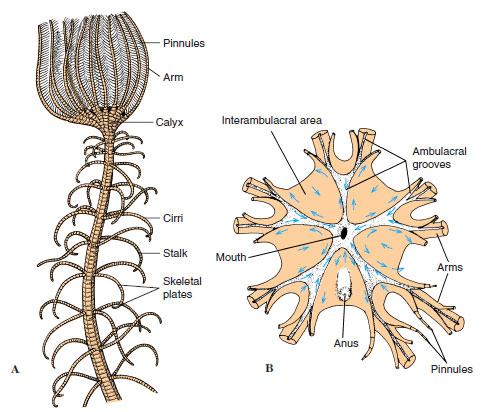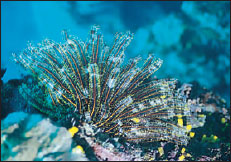Class Crinoidea
Class Crinoidea
Crinoids include sea lilies and feather stars. They have several primitive characters. As fossil records reveal, crinoids were once far more numerous than they are now. They differ from other echinoderms by being attached during a substantial part of their lives. Sea lilies have a flower-shaped body that is placed at the tip of an attached stalk (Figure 23-25). Feather stars have long, many-branched arms, and adults are free moving, though they may remain in the same spot for long periods (Figure 23-26). During metamorphosis feather stars become sessile and stalked, but after several months they detach and become free moving. Many crinoids are deep-water forms, but feather stars may inhabit shallow waters, especially in the Indo-Pacific and West-Indian–Caribbean regions, where the largest numbers of species are found.
Form and Function
The body disc, or calyx, is covered with a leathery skin (tegmen) containing calcareous plates. The epidermis is poorly developed. Five flexible arms branch to form many more arms, each with many lateral pinnules arranged like barbs on a feather (Figure 23-25). Calyx and arms together are called the crown. Sessile forms have a long, jointed stalk attached to the aboral side of the body. This stalk is composed of plates, appears jointed, and may bear cirri. Madreporite, spines, and pedicellariae are absent.
The upper (oral) surface bears the mouth, which opens into a short esophagus, from which the long intestine with diverticula proceeds aborally for a distance and then makes a complete turn to the anus, which may be on a raised cone (Figure 23-25B). With the aid of tube feet and mucous nets, crinoids feed on small organisms that are caught in their ambulacral grooves. Ambulacral grooves are open and ciliated and serve to carry food to the mouth (Figure 23-25B). Tube feet in the form of tentacles are also found in the grooves.
The water-vascular system has the basic echinoderm plan. The nervous system has an oral ring and a radial nerve that runs to each arm. The aboral or entoneural system is more highly developed in crinoids than in most other echinoderms. Sense organs are scanty and primitive.
Sexes are separate. Gonads are simply masses of cells in the genital cavity of the arms and pinnules. Gametes escape without ducts through a rupture in the pinnule wall. Brooding occurs in some forms. Doliolaria larvae (Figure 23-10F) are free swimming for a time before they become attached and metamorphose. Most living crinoids are from 15 to 30 cm long, but some fossil species had stalks 20 m in length.
Crinoids include sea lilies and feather stars. They have several primitive characters. As fossil records reveal, crinoids were once far more numerous than they are now. They differ from other echinoderms by being attached during a substantial part of their lives. Sea lilies have a flower-shaped body that is placed at the tip of an attached stalk (Figure 23-25). Feather stars have long, many-branched arms, and adults are free moving, though they may remain in the same spot for long periods (Figure 23-26). During metamorphosis feather stars become sessile and stalked, but after several months they detach and become free moving. Many crinoids are deep-water forms, but feather stars may inhabit shallow waters, especially in the Indo-Pacific and West-Indian–Caribbean regions, where the largest numbers of species are found.
 |
| Figure 23-25 Crinoid structure. A, Sea lily (stalked crinoid) with portion of stalk. Modern crinoid stalks rarely exceed 60 cm, but fossil forms were as much as 20 m long. B, Oral view of calyx of the crinoid Antedon, showing direction of ciliary food currents. Ambulacral grooves with podia extend from mouth along arms and branching pinnules. Food particles touching podia are tossed into ambulacral grooves and carried, tangled in mucus, by strong ciliary currents toward mouth. Particles falling on interambulacral areas are carried by cilia first toward mouth and then outward and finally dropped off the edge, thus keeping the oral disc clean. |
 |
| Figure 23-26 Comantheria briareus are crinoids found on Pacific coral reefs. They extend their arms into the water to catch food particles both during the day and at night. |
Form and Function
The body disc, or calyx, is covered with a leathery skin (tegmen) containing calcareous plates. The epidermis is poorly developed. Five flexible arms branch to form many more arms, each with many lateral pinnules arranged like barbs on a feather (Figure 23-25). Calyx and arms together are called the crown. Sessile forms have a long, jointed stalk attached to the aboral side of the body. This stalk is composed of plates, appears jointed, and may bear cirri. Madreporite, spines, and pedicellariae are absent.
The upper (oral) surface bears the mouth, which opens into a short esophagus, from which the long intestine with diverticula proceeds aborally for a distance and then makes a complete turn to the anus, which may be on a raised cone (Figure 23-25B). With the aid of tube feet and mucous nets, crinoids feed on small organisms that are caught in their ambulacral grooves. Ambulacral grooves are open and ciliated and serve to carry food to the mouth (Figure 23-25B). Tube feet in the form of tentacles are also found in the grooves.
The water-vascular system has the basic echinoderm plan. The nervous system has an oral ring and a radial nerve that runs to each arm. The aboral or entoneural system is more highly developed in crinoids than in most other echinoderms. Sense organs are scanty and primitive.
Sexes are separate. Gonads are simply masses of cells in the genital cavity of the arms and pinnules. Gametes escape without ducts through a rupture in the pinnule wall. Brooding occurs in some forms. Doliolaria larvae (Figure 23-10F) are free swimming for a time before they become attached and metamorphose. Most living crinoids are from 15 to 30 cm long, but some fossil species had stalks 20 m in length.




